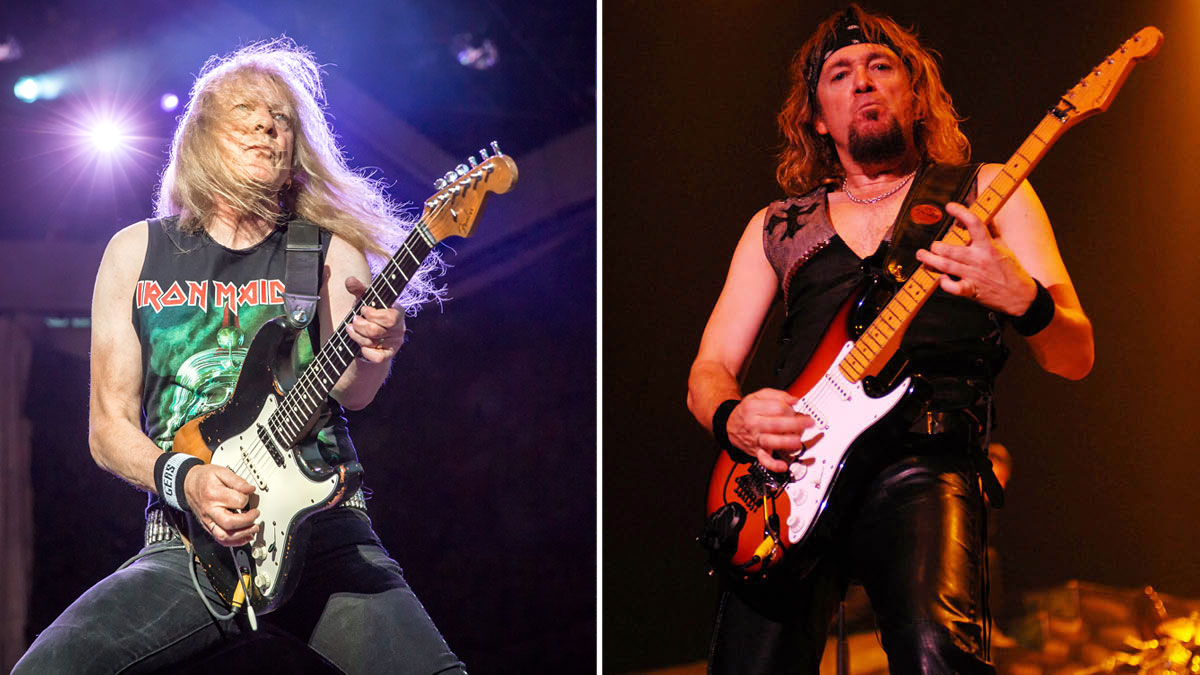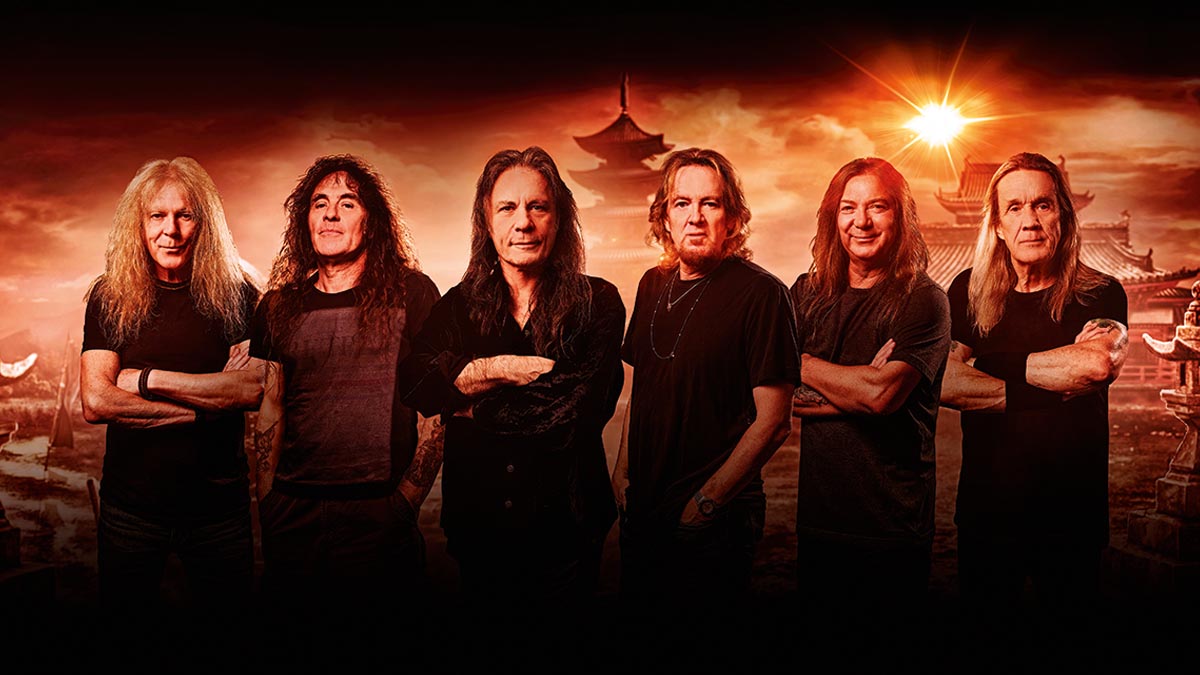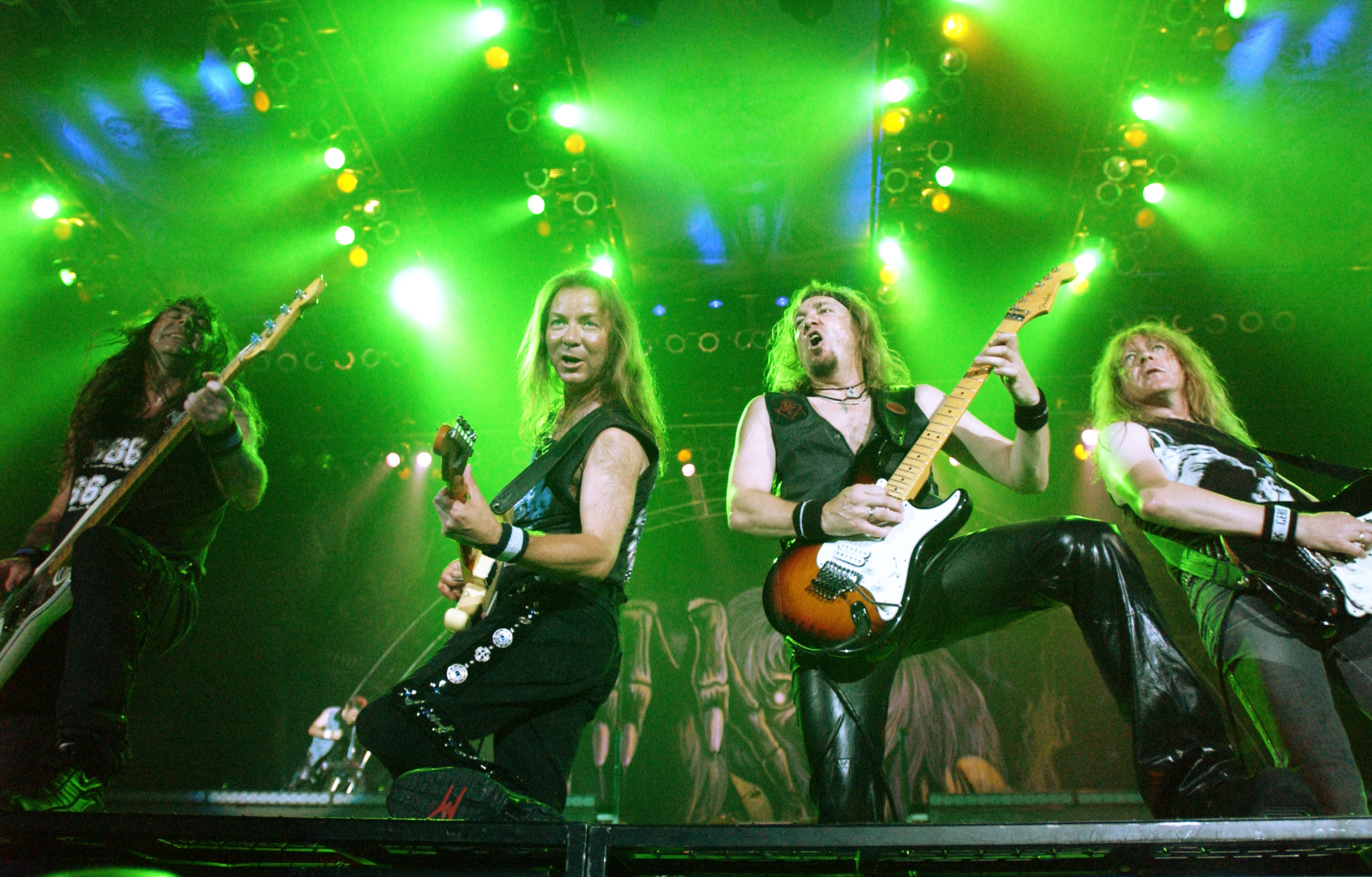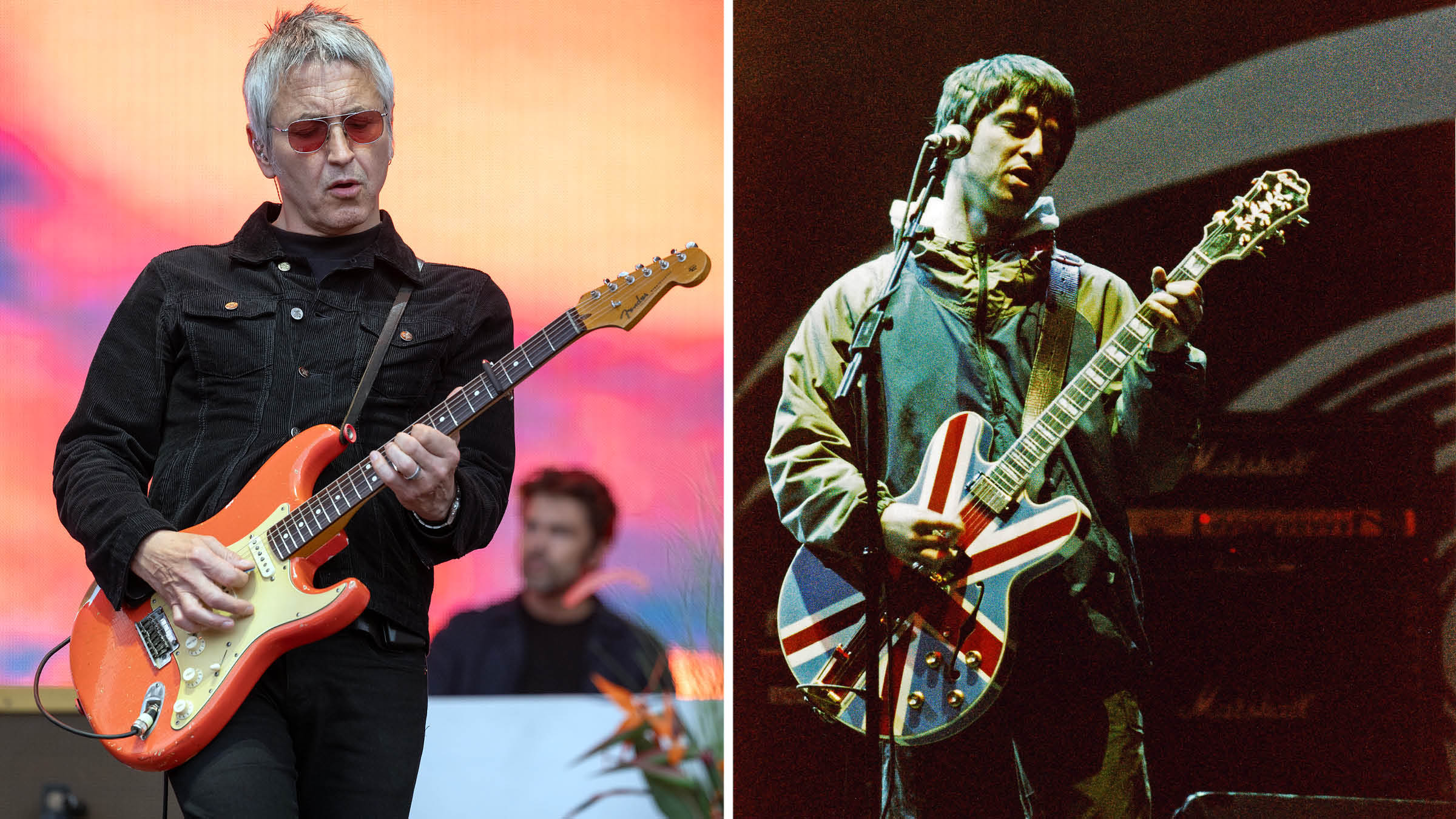Iron Maiden’s Adrian Smith and Janick Gers on Senjutsu, track by track
How complex songs and tricky time changes make for an epic record and a testing time in the studio, and why you don’t need a $3,000 guitar to sound like a pro...

They are in one of the biggest bands in the world, but when Adrian Smith and Janick Gers talk about guitars, there’s not a trace of arrogance. Quite the opposite.
Speaking to TG from their homes – Adrian in Buckinghamshire, Janick in the North East – they’re in buoyant mood about the new Iron Maiden album Senjutsu, the 17th studio set of the band’s storied career, and the sixth to feature the three-guitar line-up of Adrian, Janick and Dave Murray.
But before they get into the fine detail of Senjutsu (the title loosely meaning ‘the art of war’ in Japanese), they both offer sound advice for less experienced players. Janick has a tip for those on a modest budget, having played an Epiphone Les Paul Custom, instead of his usual Strats, when Maiden performed the song If Eternity Should Fail on their last tour.
“I wanted to do that because if you’re a kid watching Iron Maiden, I don’t want you thinking you’ve got to spend three grand to sound good,” he says. “So many guitar players think expensive guitars sound better, but the reality is people rarely can tell the difference.
“Decent guitars are out there and everyone can afford them. The difference is very slight – if there was only one guitarist in the band, you might be able to hear the difference between something costing three grand or £500. But there’s three of us, and I couldn’t hear the difference. It tells kids: ‘You can do this, get a guitar, put a band together and get playing! You don’t need to be rich to do this.’ So that’s why I chose to use that guitar.”

And what Adrian says about technique is both instructional and remarkably self-deprecating. This is a man who has written some of Iron Maiden’s greatest songs, notably the '80s anthems Flight Of Icarus and 2 Minutes To Midnight. But in the '90s, when he and singer Bruce Dickinson were out of the band and working together, Adrian had a rude awakening from Roy Z, the other guitarist in Bruce’s band.
“I’ve never really studied technique,” he admits, “because there wasn’t much information around when I was younger. But when I was playing with Roy Z, he actually called me out on it and said, ‘Your technique’s not very good!’ At first I thought, ‘Hang on a minute, mate!’ But he was right.
All the latest guitar news, interviews, lessons, reviews, deals and more, direct to your inbox!
“He showed me some alternate picking exercises and I worked on them for hours and hours because I had to keep up with him. It really improved my playing and helped me use my fingers in the right way, as well as strengthening them.”

Both of them describe Senjutsu as a challenging album to make, not least due to the complex material provided by the band’s founder and leader, bassist Steve Harris.
Recorded at Studio Guillaume Tell in Paris with producer Kevin Shirley, the album was actually completed in 2019, before the global pandemic. And across a range of styles and moods, from straight-up heavy metal to more progressive and folk-influenced textures, there is some truly stunning guitar work.
“There’s so much creativity in this band,” Janick says. “We’re always trying to expand and come up with new things, and on this album, we have such a mixture of sounds and huge choruses too. It’s a double album, and on vinyl it’s a triple! Back in the old days, an album would be 40 minutes max. Well, this is three times that! And that’s what validates this band.”
In every sense, this is a heavyweight album. And in the following track-by-track guide, Adrian and Janick reveal the secrets of its creation – weird tunings, odd time changes and a super-sized solo included!
1. Senjutsu
A dramatic opener that uses Phrygian ideas to hammer home the album’s Eastern themes
Adrian: “The title track was inspired by Japanese drums. We put my demo up on Pro Tools and Nicko [McBrain, drummer] played along to it. Then we took the digital drums out and added guitars.
“We got the drum and guitar track ready to go first. I had a couple of melodies and because of the Eastern nature of it, Steve [Harris, bassist] suggested a battle scene – an army trying to scale the walls of a city. Full-on drama!”
2. Stratego
One of the more succinct offerings, using the same power chord to minor sixth shifts heard on some of the group’s classic '80s material
Janick: “I wrote a lot of the music for this one and Steve brought his melodies in. It’s a basic rock ’n’ roll track with some extra creativity thrown in.
Adrian: “That power chord to minor sixth shift is very dark-sounding and always very effective. It sets up a mood and away you go! It defines the sound of the song, with that element of discordance to it.”
3. The Writing On The Wall
The lead single that goes from cowboy to Celtic in just 30 seconds
Adrian: “This was one of my songs so I gave myself a nice long solo! It’s always been 16 bars with Maiden – every solo is that length. I’d never done 32, so I thought I’d give myself double this time. And that was actually quite a challenge, trying to build it up into something interesting. So I did the big melodic solo, then Dave plays one too and Janick plays the outro stuff. But we had a lot of trouble with that main simple riff in the D position.
“When three guitars play it, because of intonation, it never sounded right to me. Two guitars sounded right but three sounded a bit off. So Janick tracked the higher one and I played the lower one. And that part almost sounds like a horn line.”
Janick: “There’s definitely a Celtic feel to this one. When we bring songs in, anything goes. Nothing is sacred. That’s what gives this band so much depth. There’s that cowboy feel at the beginning, too. It all goes together really well and still sounds like Iron Maiden.”
4. Lost In A Lost World
An experimental 10-minuter, with some head-turning time shifts and mirrored vocal melodies
Adrian: “Steve has a very different take on things, which for the most part is a real strength – because it makes us sound different to anything else. He’s got a knack for these time changes, and sometimes they’re hard to get your head around, but having worked with him for many years, I can almost anticipate where he’s going to go. I think we all can. That’s the beauty of having a band that have played together all these years.”
Janick: “We’re not scared to head off in different directions in the middle of a song. It doesn’t matter how long the song ends up being – if it feels right, be prepared to go there. As for guitar tracks mirroring the vocals, sometimes we might put them down before Bruce and other times we’ll add them after. It’s different each time. It gives the guitars a higher octave and takes the sound to a different place, adding to the vocal line.”
5. Days Of Future Past
An uptempo, Smith/Dickinson-penned modern metal rager
Adrian: “It’s got quite a modern feel in places and it’s only four minutes, so it’s the shortest track on the record. The riff that comes in at 30 seconds feels very fresh and youthful. It uses the E position on the seventh fret and then you use one finger to play a C bass note, then down to the A.
“It’s almost a Spanish flamenco thing if you play it on acoustic with a bossa nova rhythm, but then you plug into a Marshall and play it differently, it sounds like a rock song! I like that E chord with the movement underneath.”
6. The Time Machine
The sound of Gers and Harris penning their own prog rock opera
Janick: “This is the one with the weird tunings for all the extra colour at the beginning. It was actually all done on the Strat. To be honest, I was going to redo it on acoustic, but the Strat had such a weird sound that the acoustic wouldn’t have gotten.
“I threw everything into the works for this one. We’ve always loved longer, more drawn-out tracks and even though we’re considered heavy metal we can also be folky, edgy, progressive and also very soft in places. In some respects, our way of looking at an album is everything’s possible!
“All you need, really, is a powerful chorus. Then you layer the guitars, it’s our job to make a tapestry underneath that enhances Bruce’s vocals rather than getting in the way. We have a natural way of playing. We don’t work it out much, it’s just there.”
7. Darkest Hour
A brooding neoclassical ballad with some extra depth from Smith’s double neck
Adrian: “For this I used my double-neck Jackson, with a six and a 12. It weighs about three-quarters of a ton! But it sounded really good in the studio, especially for a ballad-y kind of song.”
8. Death Of The Celts
The first of the album’s three Harris-penned closing tracks – with some surprise shifts from minor to major
Adrian: “It’s funny – Steve will have these ideas and then look at me, Dave or Janick. The ideas are usually quite complicated, so sometimes you might see guitarists hiding away behind their amps, waiting for the others to take up the gauntlet and learn these super-complicated parts! But we all do our bit. It takes a lot of concentration to play Steve’s stuff. Honestly, it can be quite a challenge.”
Janick: “We made this album very differently. Normally, we get a studio to rehearse in and then get seven or eight songs ready as a live band first before we record. But this time it was all done in the studio. We went in and actually learned things there, putting them down soon after and then moving on to the next. So it got quite confusing, especially with the longer songs.
“There were so many melodies and riffs floating around in the studio. Songs like Death Of The Celts were done in parts. Sometimes we’d be playing three-part harmonies together. And there were a lot of tempo changes. Steve would have a riff and melody for us to memorise, then there would be a tempo change, then we’d be back to the melody but a different tempo! It wasn’t an easy album to make.”
9. The Parchment A
A moody mixture of Phrygian and Phrygian Dominant tonalities on arguably the album’s darkest track
Janick: “This one has that Egyptian feel to it. With Maiden, we love the imagery that comes through the music. We can take people places, and that’s the great thing about music and playing guitar. You think about what you’re playing and how you can transport the listener. That’s something magical.”
10. Hell On Earth
A fittingly epic conclusion to the album, with mellowed clean tones before the heavy metal thunder arrives…
Adrian: “On those Marshall JVMs, you’ve got two clean channels and two dirty channels, and each one has three different modes. There are a lot of different tonal options there. With clean sounds, compression is very important – well, compression is important in general for recording because it keeps everything tight and punchy-sounding. Maiden have always been known for putting lighter shades in songs. Dynamics are very important to us.”
Janick: “This is such a thematic end to the album, with so much power. It’s very cinematic and I love how all the guitars interact with each other. It’s heavy but it has so much soul to it. It’s an album we can be proud of. I can’t sit here and tell you this is the best album we’ve ever done. That would be stupid. But I’m very proud of it – as proud as I am of any Maiden album.”
- Senjutsu is out now via Warner Bros.
Amit has been writing for titles like Total Guitar, MusicRadar and Guitar World for over a decade and counts Richie Kotzen, Guthrie Govan and Jeff Beck among his primary influences as a guitar player. He's worked for magazines like Kerrang!, Metal Hammer, Classic Rock, Prog, Record Collector, Planet Rock, Rhythm and Bass Player, as well as newspapers like Metro and The Independent, interviewing everyone from Ozzy Osbourne and Lemmy to Slash and Jimmy Page, and once even traded solos with a member of Slayer on a track released internationally. As a session guitarist, he's played alongside members of Judas Priest and Uriah Heep in London ensemble Metalworks, as well as handled lead guitars for legends like Glen Matlock (Sex Pistols, The Faces) and Stu Hamm (Steve Vai, Joe Satriani, G3).

